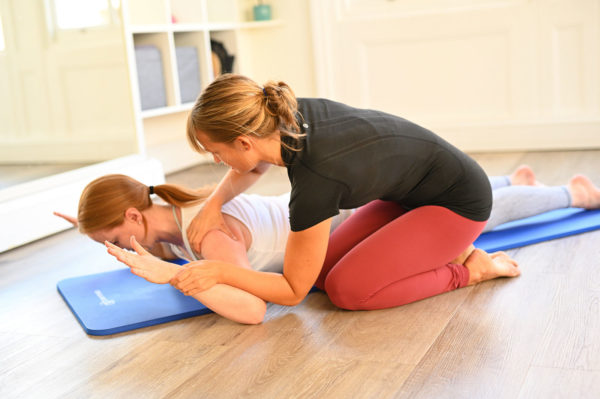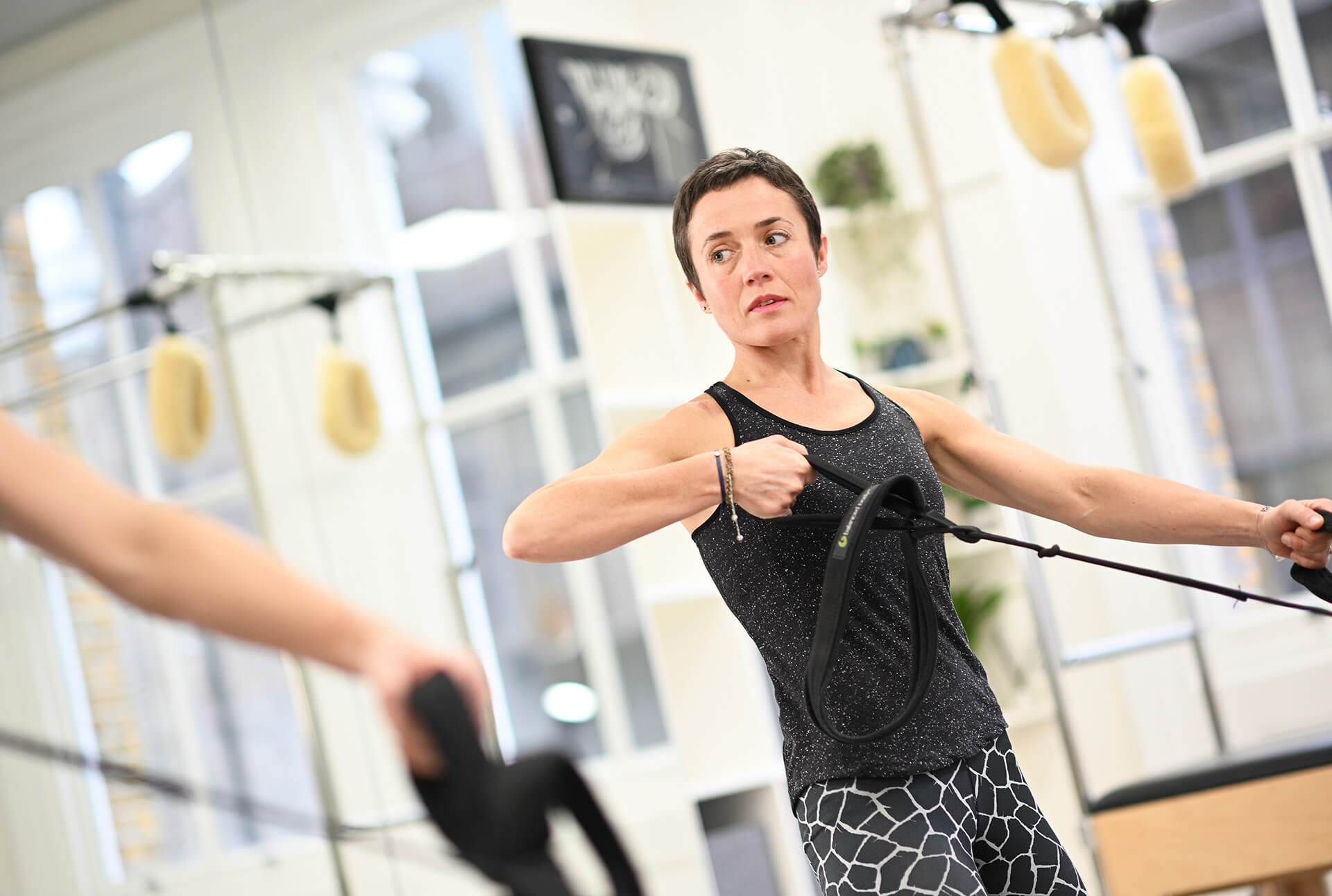Key Contributor: Gwen Berwick, Clinical Pilates Instructor
Do you sit down all day? Do you complain about how bad your posture is? Are you wondering how Pilates can help your posture?
One important thing to remember about posture is that ‘good posture’ does not mean sitting up straight! It also doesn’t mean standing upright. In fact, good posture should actually be about your ability to move in and out of different positions with ease.
The key to good posture is not stretching, but actually strengthening your muscles so that you can be more upright against forces like gravity!
So does Pilates help with posture?
Pilates helps with posture as it helps to engage the deep core muscles in what was originally known as ‘the powerhouse’ – the abdominals, back and pelvic floor – which enables you to relax your shoulders and neck and alleviate pressure on your hips, legs and feet, in turn, improving your posture.
If you spend most of your day slouched over your computer then you – like the millions of others with desk jobs – may be suffering with poor posture caused by an excessively rounded upper back and reduced strength.
And while we all know a hunched spine looks bad, it may surprise you to learn that it also negatively affects your health.
Rounding your back changes how your rib cage sits which can put pressure on the organs. It prevents the ribs and lungs from expanding properly which leads to shallow breathing. Studies have shown poor breathing patterns are bad for both your mental and physical wellbeing. A forward head posture caused by constantly craning your neck at your computer screen can also be harmful to the central nervous system.
Another consequence of a constantly rounded spine is a stiff thoracic (the mid-spine region). If one area of your body is stiffer, something else normally takes the strain. Consequently, a stiffer thoracic puts more pressure on other areas of the spine which can contribute to lower back pain or neck ache.
In this article, we’ll be discussing what the benefits of good posture are and how Pilates in particular, can help you achieve that upright posture we all so wish for.

The Benefits of good posture
Not only does posture change your entire appearance, there are also a whole host of health benefits that come with having better posture.
Improved breathing capabilities
Poor posture is proven to impact your ability to breathe optimally. Slouching, rounded shoulders and forward head postures reduces our ability to breathe deeply by tightening the muscles around the chest which limits the ability of the rib cage to expand and breathe deeper.
Relieves pain in the back and neck
Whilst improving your posture may not combat the root cause of your back and neck pain if there is an underlying issue, poor posture can contribute to your back pain.
When you’re slouching or hunching forward for example, stress and pressure may develop in the muscle tissue, spinal joints and discs in ways they aren’t designed to endure.
With good posture, muscles around the spine are not under pressure and are distributed in a way to use the muscles as they are intended.
Improves mobility and range of motion (ROM)
Posture is directly linked to mobility as we have a greater range of motion in our joints when we maintain a good posture. According to Bill Fabrocini, “If we have a stable core that can keep the spine still and in alignment, then distal joint mechanics are improved to maintain mobility through the hip and shoulder girdles.”.
Increases self-confidence
When you stand up tall, you look and feel more confident, self-assured, and poised.
Improves circulation
Maintained good posture naturally increases the circulation to and from your heart. By stretching the abdominal and chest muscles you improve both posture, lung functionality and in turn, circulation.
Supports digestion
Research suggests that poor posture can have a profound impact on your digestion. Slouching after a meal can cause heartburn by putting additional pressure on the abdomen. Maintaining good posture ensures your internal organs are well aligned, reducing compression on your stomach, intestines and liver, and therefore reduces the chance of digestive stress.
What do our experts say?
Maintaining good posture amidst the demands of daily life can be very challenging. Pilates offers an excellent method to help develop deep internal support, creating an internal scaffold that helps us stand effortlessly upright without conscious effort. This can result in a sense of lightness and ease, enabling us to discover our true movement potential and live a healthy, active life, regardless of our age, profession, or activities. Gwen Berwick.
4 key Pilates exercises for posture correction
1. Pelvic Tilt
Finding your neutral spine is a common instruction in a Pilates class. Your neutral spine is when the 3 curves of your spine – your cervical (neck), thoracic (middle) and lumbar (lower) curves – are intact.
Pelvic tilts are one exercise to help find your neutral spine.
- Lie on your back on a mat with your feet flat on the floor with legs bent, hip-distance apart and parallel to one another. Allow your arms to rest down at your side with the palms facing up or down.
- Awareness is vital for finding your neutral spine in all different positions.
- Without it you won’t know when your spine is tucked, over-extending, or just right. So, just lie there and allow your body to melt into the mat. Breathe deeply and focus on your pelvic and lower back region.
- Now, make a triangle with your hands by bringing your thumbs together and the tips of your index fingers together. Bring your hands in this shape onto your lower abdomen with the tip of your index fingers resting on your pubic bone. Your hands should be flat before beginning the exercise.
- Imagine there is a clock on the front of your pelvis where your hands are. The 12 o’clock points up at your belly button, while the 6 o’clock points towards your pubic bone. 3 ‘o clock and 9 o’clock point towards your bony hip points.
- Exhale and tilt the pelvis so that the 6 o’clock (your pubic bone) is pointing upwards and 12 o’clock (your belly button) has sunk down to come nearer the mat.
- Tilt your pelvis the other way so that the 6 o’clock is now nearer the mat and the 12 o’clock is higher. This should create a bigger curve in your lower back.
- Perform this rocking motion until you start to feel the gentle contraction and relaxation.
2. The Mermaid
The mermaid is a great exercise to increase mobility around your mid back, also known as the thoracic spine.
Particularly important for those who sit at a desk all day, this desk will stretch the sides of your body, relieve tension and lengthen your body.
- Start cross legged moving your legs into a Z shape cupping your bottom with your back leg and foot.
- Place your hand closest to the front leg on the floor.
- Lift your opposite arm towards the ceiling and reach over towards your front leg into side bend.
- Use the supporting arm and abdominals to push yourself back up to sitting.
- Repeat two to three times and on the next tip add in rotation.
- Try to reach underneath the supporting arm, allowing your rib cage to move.
- De-rotate yourself back to your side bend and repeat the twist 3-4 times before coming back up to sitting and switching to the other side. Remember to change the legs round before repeating on the other side.
3. Thoracic extension over a ball
You will need a Pilates mat and a soft ball, a mini stability ball or a Pilates ‘over’ ball.
- Come to lie on your back with your knees bent and your legs sit bone width apart.
- Next, take the soft ball and place it behind your mid-back. This is the space between your shoulder blades.
- Interlace your fingers to make a basket and then slide them behind the base of your head. Your head is heavy (it weighs around 10 pounds!), so make sure you actually use your hands to support it.
- Bring your elbows into your peripheral vision.
- Your pelvis should be in a relatively neutral position. This means that your pelvis and bum is neither tucked under (so that your back is flat) nor is it duck-like and sticking out.
- On an exhale, slowly allow your shoulders, neck, head and upper spine to extend backwards over the ball. Go to the point just before your ribs pop up.
- Pause while you are in the spine extension phase. Take a few breaths here and enjoy the stretch!
- On an exhale, think about your chest lift to bring you back up. Start to move through your chest to bring your head, neck and shoulders back up over the ball to the starting position.
4. Pilates plank
- Start on your hands and knees with your directly under your hips and your hands placed under your shoulders.
- Hover your knees off the floor and then step one foot backwards and then the other so you’re in a straight line from your hips to your head.
- Hold the position for around 30seconds to 1 minute.
- Open the sit bones to walk one leg in and then the other, back into your knee hover, before lowering to the ground.
- Repeat 1 or 2 times.
Improve your posture with Complete Pilates
If you’re wanting to improve your posture and looking for some expert guidance, Complete Pilates offers a range of options tailored specifically to you, including 1-to-1 and small group classes at our studios or online.
We have a range of classes to choose from including:
- Pilates for beginners
- Pregnancy Pilates
- Postnatal Pilates
- Rehab Pilates
- Online Pilates
- Group Pilates
Come and try Pilates in the City of London, or any of our studios (see our Chelsea Pilates studio or North London Pilates studio) for more information, please get in touch online or contact us on 0203 764 5668.
These blogs are designed to give information to everyone, however, it is important to remember that everyone is different! If you have not seen one of our therapists and have any questions about injuries, what you have read or whether this may be useful to you, please just ask. We are more than happy to help anyone and point you in the right direction. Our biggest belief is that education is key. The more you understand about your injury, illness and movement, the more you are likely to improve.




